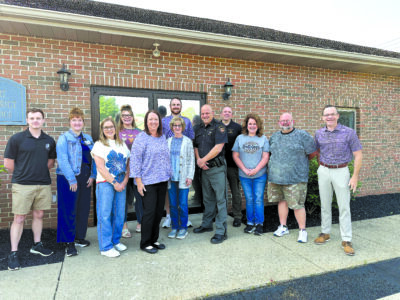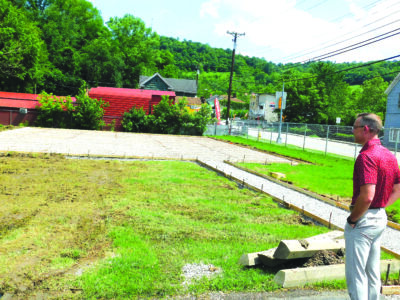Public airs concerns to EPA in East Palestine
EAST PALESTINE — When the Environmental Protection Agency opened the floor to questions at the conclusion of Thursday’s air monitoring informational session at The Way Station in East Palestine, residents were ready. The EPA was not.
Frustrated residents voiced skepticism in the agency’s data collected in response to February’s Norfolk Southern train derailment and accused the EPA of ignoring residents who have reported concerning levels of vinyl chloride metabolites in their urine and lacking concern for those who live outside the immediate perimeter of the derailment site.
Rev. Barry Walker, who lives a mile from the site, questioned the EPA’s decision to not send the Trace Atmospheric Gas Analyzer (TAGA) bus, a self-contained mobile laboratory capable of real-time monitoring of outdoor air, further into the community.
“There are some of us a mile or two out from this thing. You don’t cover us,” Walker said, addressing members of the EPA. “You are not checking (the air). You won’t change the route. You won’t check the air at night. You are not testing for vinyl chloride.”
U.S. EPA Region 5’s Matt Villicana, who was joined by the agency’s response coordinator Mark Durno and Community Involvement Coordinator Diane Russell, explained that since vinyl chloride levels are being detected at such low levels at the site itself it would be unlikely that levels would be detected elsewhere in the area any higher.
“If we are not seeing it in close proximity, we are not expected to see it further out,” he said.
While the EPA data shows little to no risk to vinyl chloride exposure, some residents insist they have data that proves not only prior exposure to the chemical but continuous exposure, as well.
Eric “Jake” Cozza, who lives less than a half a mile from the derailment site, is one of those residents. Cozza provided results of a urinalysis from Labcorp that shows a presence of thiodiglycolic acid (TDGA) or vinyl chloride metabolite at .60 mcg/ml.
The result lists the reporting level at .50. TDGA is the body’s major breakdown product of vinyl chloride and a biomarker for exposure. Vinyl chloride breaks down in the body rapidly. According to the Agency for Toxic Substances and Disease Registry (ATSDR), “specific tests for the presence of vinyl chloride in the breath or breakdown products in the urine are available, but they must be performed shortly after exposure … urine levels of thiodiglycolic acid peak about 20 hours after exposure.” If the Lapcorp results are accurate, Cozza is still being exposed to vinyl chloride.
“Now that people are finally getting tested, they are testing positive for this stuff,” Cozza said to Durno. “I went to 13 chemists and toxicologists that all said after two months we shouldn’t have this in our urine. I had to fight to get a prescription to even get a test. I am scared to death and I have six people in my home. I can’t just pick up and leave. What you people are telling us and what our test results say is completely different.”
Durno was sympathetic to Cozza’s situation but also perplexed by it.
“I know that blood and urine samples with these compounds are an increasing concern. We heard it last week, we heard it at the town hall meeting,” Durno said. “That tough part is we have the site. We know the site is contaminated. We have the river. Sulphur Run is contaminated and part of Leslie Run is contaminated. And with the work that is going on there is the potential for vapors to be released. With the monitoring, we are seeing some levels but it’s not sustainable and we just are not seeing around the perimeter of the site those releases.”
While the air is not being tested for dioxins, the EPA’s air monitoring equipment is capable of detecting vinyl chloride at between 10 and 8 parts per billion. The action level is 20 parts per billion. None of the data collected has shown levels that would sound an agency alarm. Low levels of butyl acrylate are more difficult to monitor with the equipment, but the equipment is capable of detecting levels at action levels. According to the EPA, those numbers have not been exceeded. Still, the agency acknowledged the smell of the chemical is noticeable.
“I was just down at a house watching the operation from the backyard which is basically the site of the backyard,” Durno said. “And as the excavation was going on and the wind flow was actually in my direction, I got a small whiff of butyl acrylate.”
To keep vapors from escaping the site, Villicana said the EPA has instructed Norfolk Southern to use as much vapor suppressant foam as needed.
“We’re actively telling Norfolk Southern to make sure they’re using that stuff liberally, to make sure we keep those vapors down because even the vapors can be an irritant and we don’t want that,” he said.
The EPA insists the air quality in East Palestine remains safe and reiterated that the agency trusts its science and its data.
Some East Palestine residents are not convinced. They don’t trust the data or the agency. Some accused the EPA of withholding information and questioned the EPA’s transparency.
But Durno denies any information is being withheld. If anything, he said the agency has released more data than it has in similar situations.
“When we put up the air data, that is preliminary data. We are putting that data up before it has been calibrated. We typically don’t do that.” he said. “Soil data is a different story. We need to make sure that data is validated. But with the soil data there aren’t immediate risks and we don’t want bad data and so we are waiting.”
Water data is provided by Norfolk Southern and Durno said he could not guarantee the water results were up to date, but he stressed that while the work is being done by the railroad, the oversight is being done by the EPA.
Durno reassured the residents that the EPA and East Palestine are working toward a common goal — complete remediation of the village. He also said that the agency will release more soil data soon.
“Some semivolatile and dioxin data, we are going to be posting within the next couple days. We will have some preliminary data,” he said. “We literally just talked to our lab and what we call our environmental unit personnel and we agreed that we are going to be posting that preliminary data. So we hear you and we agree with you.”
A third informational session will be held Thursday from 6 to 7 p.m. at The Way Station located at 109 W Rebecca St. That session will include input from the Columbiana County Health Department and focus on private well testing.




